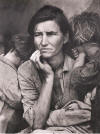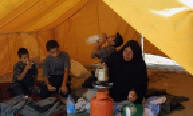Home Demolitions in Palestine
Tractored Out by the Cats
From The Grapes of Wrath:
 The
tractors came over the roads and into the fields, great crawlers moving
like insects, having the incredible strength of insects….The man sitting
in the iron seat did not look like a man; gloved, goggled, rubber dust
mask over the nose and mouth, he was part of the monster, a robot in the
seat…
The
tractors came over the roads and into the fields, great crawlers moving
like insects, having the incredible strength of insects….The man sitting
in the iron seat did not look like a man; gloved, goggled, rubber dust
mask over the nose and mouth, he was part of the monster, a robot in the
seat…
A twitch of the controls could swerve the cat’, but the driver’s hands
could not twitch because the monster that built the tractor, the monster
that sent the tractor out, had somehow gotten into his brain and muscle,
had goggled him and muzzled him—goggled his mind, muzzled his speech,
goggled his perception…He could not see the land as it was, he could not
smell the land as it smelled; his feet did not stamp the clods or feel
the warmth and power of the earth. He sat in an iron seat and
stepped on iron pedals. …
The iron gate [of the cat’] bit into the house corner, crumbled the
wall, and wrenched the little house from its foundation so that it fell
sideways, crushed like a bug. And the driver was goggled and a
rubber mask covered his nose and mouth. The tractor cut a straight
line on, and the air and the ground vibrated with its thunder. The
tenant man stared after it, his rifle in his hand. His wife was
beside him, and the quiet children behind. And all of them stared
after the tractor. Chapter 5
When the
Caterpillar tractors tore into the homes of the tenant farmers of the
Depression-era Midwest and made them homeless, refugees in a land they
had cared for and cultivated for years, it was for the greed of the few,
and the new world order that could think only of profit. Human
lives, the health of the earth, were not to be considered.
 Today
in Palestine Caterpillar bulldozers are again at work; destroying homes,
crops, and working to crush the hope of the people. Here it is the
machinery of colonialism, of taking the land of the native inhabitants
and getting rid of its people.
Today
in Palestine Caterpillar bulldozers are again at work; destroying homes,
crops, and working to crush the hope of the people. Here it is the
machinery of colonialism, of taking the land of the native inhabitants
and getting rid of its people.
An Israeli bulldozer operator explains:
"For three days, I just demolished non-stop. The whole area. Any
house they fired from came down. And to knock it down, I tore down some
other houses. [The Palestinians] were warned by loudspeakers to get out
of the house before I come, but I gave no one a chance. I didn't wait. I
didn't give just one [warning] push, and wait for them to come out. I
would just ram the house with full power, to bring it down as fast as
possible. I wanted to get to the other houses. To get as many as
possible. ...I didn't give a damn about the Palestinians, but I didn't
just ruin with no reason. It was all under orders.”
From an interview with a Cat' driver, who under orders of his Israeli
military superiors, operated a giant Caterpillar D-9L bulldozer and
helped make 4,000 camp residents homeless in Jenin refugee camp, April
2000. The interview below was published in Yediot Aharonot, the
Israeli daily with the widest circulation, on May 31, 2002.
According the United Nations, as of May 2003, a total of 12,000
Palestinians have been had their homes demolished since the beginning of
the intifada in September 2000. This number has no doubt risen
drastically since then, as one military incursion in Rafah, Gaza alone
left over 1,000 without their homes, and this was accomplished in just 3
days, in October 2003.
The Israeli Committee Against House Demolitions (ICAHD) estimates that some 27,000 Palestinian structures have been demolished since 1967. 12,000 since 2000, after the "Oslo Accords" were signed at the White House.